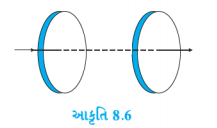Text Solution
Verified by Experts
|
Topper's Solved these Questions
ELECTROMAGNETIC WAVES
NCERT GUJARATI|Exercise ADDITIONAL EXERCISES|5 VideosView PlaylistELECTROMAGNETIC WAVES
NCERT GUJARATI|Exercise ADDITIONAL EXERCISES|5 VideosView PlaylistELECTROMAGNETIC INDUCTION
NCERT GUJARATI|Exercise ADDITIONAL EXERCISES|7 VideosView PlaylistELECTROSTATIC POTENTIAL AND CAPACITANCE
NCERT GUJARATI|Exercise EXERCISES|35 VideosView Playlist
Similar Questions
Explore conceptually related problems
Knowledge Check
A
B
C
D
Submit
A
B
C
D
Submit
Similar Questions
Explore conceptually related problems
NCERT GUJARATI-ELECTROMAGNETIC WAVES-EXERCISES
- Figure 8.6 shows a capacitor made of two circular plates each of radiu...
06:10
|
Playing Now - A parallel plate capacitor (Fig. 8.7) made of circular plates each of ...
05:16
|
Play - What physical quantity is the same for X-rays of wavelength 10^(–10)m,...
00:55
|
Play - A plane electromagnetic wave travels in vacuum along z-direction. What...
03:25
|
Play - A radio can tune in to any station in the 7.5 MHz to 12 MHz band. What...
01:26
|
Play - A charged particle oscillates about its mean equilibrium position with...
02:54
|
Play - The amplitude of the magnetic field part of a harmonic electromagnetic...
01:11
|
Play - Suppose that the electric field amplitude of an electromagnetic wave i...
07:48
|
Play - The terminology different parts of the electromagnetic spectrum is giv...
09:07
|
Play - In a plane electromagnetic wave, the electric field oscillates sinusoi...
04:14
|
Play
